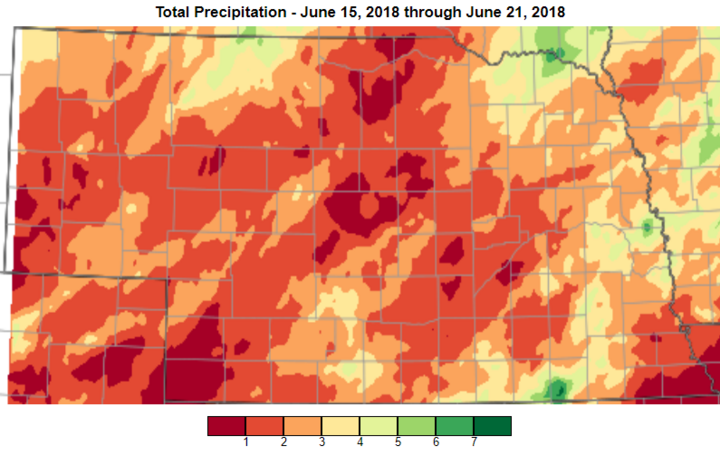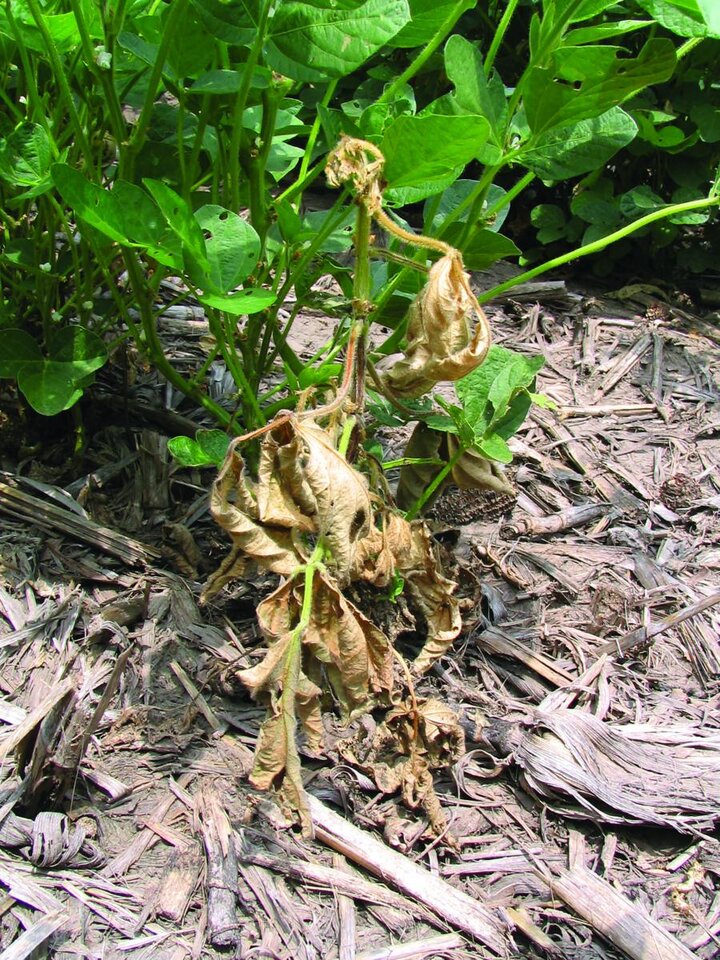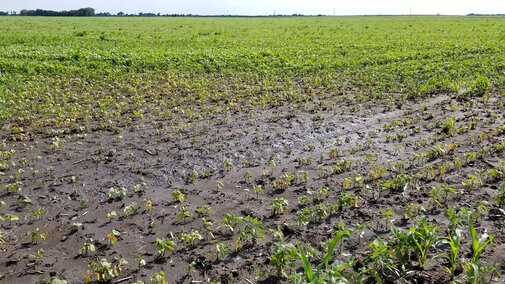It is Friday morning and the sun is finally showing up in northern Nebraska. With the weather pattern this past week, it was starting to feel like the Pacific Northwest. Areas of the state have seen significant amounts of rain in the last week (Figure 2) and, in turn, are experiencing flooding and ponding in their fields.
The extent to which flooding damages soybean depends on several factors, including:
- growth stage of the soybeans at flooding,
- frequency and duration of flooding,
- air-soil temperature during flooding, and
- rate of drying after the flood event.

The most important impact of flooding is on overall plant respiration. When flooding occurs, there is a reduction in the exchange of air (oxygen) between the soil and atmosphere. This leads to decreased total root volume, reduced water and nutrient transport through the roots to the shoots, and an accumulation of sulfides and butyric acid produced by microorganisms. These compounds are toxic to the plant. Depending on the length of time the roots are waterlogged, it could lead to cell death and root death.
Soybeans are generally able to handle a fair amount of flooding without sustaining major impacts. Yield losses are seldom observed in fields flooded for 48 hours or less. Fields flooded for four or more days stress the crop which causes delays in plant growth and thus shorter plants with fewer nodes. Once they sustain six or more days of flooding, there are more decreases in yield and after seven days there is significant loss of stand. It is important to note that there is a significant amount of genetic variability for flooding tolerance in maturity group II and III soybeans (VanToai et al, 1994).
The rate at which a field dries following a flood significantly impacts soybean survival (Sullivan et al, 2001). Research has shown that yield reductions are much greater for fields with clay soils versus those with silt loam soil flooded for the same period of time. The data has shown at V4 yield losses of 1.8 bu/ac per day of flooding was observed on clay soils and 0.8 bu/ac per day on silt loam soils. Just like we observe in corn, once reproductive development has started, there is more detrimental impact on yield. Flooding that occurs at R1 growth stage can have yield losses of 2.3 and 1.5 bu/ac per day on clay and silt loam soils, respectively (Scott et al, 1989). Those yield losses increase once soybean are in the R3 to R5 growth stages.
Soybeans Diseases That Develop Following Flooded Conditions
Saturated soils and flooded conditions promote a number of diseases in soybeans that producers and crop consultants should watch for now and later in the season. Wet conditions are favorable for several pathogens to sporulate, germinate, and/or infect plants. Below are a few of the diseases that are more common in corn subjected to flooded conditions.
Pythium
Wet conditions are favorable for Pythium which is our most common seedling disease of soybean in Nebraska. Cooler soil temperatures will make this worse as the seedling will be stressed and grow more slowly. Typical symptoms of Pythium will include seed decay, pre-emergent seedling rot, and seedling damping off after emergence. If the plant has emerged, it often may have a root system where the outer layer can be easily pulled off and the center of the root will stay intact.
Phytophthora
As soil conditions warm up, Phytophthora often will become more common with heavy rains. Fields will typically have a history of this disease which will flare up when rains saturate soil profiles. Phytophthora is often indicated when a field was planted with a standard rate of seed treatment but still has significant stand reduction when wet conditions occur. This will be a field-specific issue and usually does not occur as often as Pythium.
Typical symptoms of Phytophthora are seed decay and pre-emergence seedling rot, and seeding damping off after emergence. Typical symptoms on seedlings are darkened stems at the base of the plant coming up from the soil line. When young plants are cut at the lower stem, often there will be a dark center to the stem. Phytophthora can kill plants at any stage of development, but Pythium typically does not kill plants much past the V5 growth stage.

References
Scott, H.D., J. DeAngulo, M.B. Daniels, L.S. Wood. 1989. Flood duration effects on soybean growth and yield. Agron J. 81:631-636.
Sullivan, M., T VanTooai, N. Fausey, J. Beuerlein, J. Parkinson, A. Soboyejo. 2001. Evaluating on-farm flooding impacts on soybean. Crop Sci. 41:93-100.
VanToai, T.T., Beuerlein, J.E., Schmitthenner, A.F., and St. Martin, S.K. 1994. Genetic variability for flooding tolerance in soybeans. Crop Sci 34:1112-1115.

